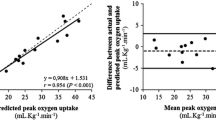Summary
The purpose of this study was to evaluate the usefulness of ratings of perceived exertion (RPE) as an indicator of exercise intensity in patients with chronic obstructive pulmonary disease (COPD). The subjects were ten male patients with COPD, whose mean forced expiratory volume in 1 s was 1.091, SD 0.41, and ten healthy middle-aged men. Ramp incremental exercise on a cycle-ergometer was performed and RPE was determined by the Borg 15-point scale. The absolute oxygen uptake at each RPE was significantly greater in the healthy subjects than in the patients with COPD. However, oxygen uptake calculated as a percentage of maximal at any RPE did not differ significantly between the two groups. Arterial blood lactate concentration at points 15 to 19 on the RPE scale was increased in healthy subjects (P<0.05–P<0.001), while the dyspnoea index at points 11 to 19 on the RPE scale was higher in patients with COPD (P<0.05–P<0.001). The main complaints on stopping exercise were dyspnoea in the patients with COPD and fatigue in the healthy subjects. Although the nature of RPE may have been different in the two groups, RPE could be a possible indicator of exercise intensity when physicians prescribe exercise to patients with COPD.
Similar content being viewed by others
References
American Thoracic Society (1987) Standards for the diagnosis and care of patients with chronic obstructive pulmonary disease (COPD) and asthma. Am Rev Respir Dis 136:225–244
Barach AL, Bickerman HA, Beck G (1952) Advances in the treatment of nontuberculous pulmonary disease. Bull NY Acad Med 28:353–384
Borg G (1970) Perceived exertion as an indicator of somatic stress. Scand J Rehabil Med 2–3:92–98
Borg G, Linderholm H (1970) Exercise performance and perceived exertion in patients with coronary insufficiency, arterial hypertension and vasoregulatory asthenia. Acta Med Scand 187:17–26
Borg G, Ottoson D (1986) The preception of exertion in physical work. Wenner-Gren Center International Symposium series 46: MacMillan Press, London
Brown HV, Wasserman K (1981) Exercise performance in chronic obstructive pulmonary diseases. Med Clin North Am 65:525–547
Cafarelli E (1977) Peripheral and central inputs to the effort sense during cycling exercise. Eur J Appl Physiol 37:181–189
Carton RL, Rhodes EC (1985) A critical review of the literature on ratings scales for perceived exertion. Sports Med 2:198–222
Chida M, Ichioka M, Makiguchi K, Miyazato I, Suda Y, Yoshida T (1987) Anaerobic threshold in chronic obstructive pulmonary disease. J Hum Ergol 16:151–155
Cox NJM, van Herwaarden CLA, Folgering H, Binkhorst RA (1988) Exercise and training in patients with chronic obstructive lung disease. Sports Med 6:180–192
Ekblom B, Goldberg AN (1971) The influence of physical training and other factors on the subjective rating of perceived exertion. Acta Physiol Scand 83:399–406
Gutmann MC, Squires RW, Pollock ML, Foster C, Anholm J (1981) Perceived exertion-heart rate relationship during exercise testing and training in cardiac patients. J Cardiol Rehabil 1:52–59
Hughes RL, Davison R (1985) Prescribing exercise for your COPD patients. J Respir Dis 6:23–36
Killian KJ (1985) The objective measurement of breathlessness. Chest 88:84S–90S
Noble BJ (1982) Clinical applications of perceived exertion. Med Sci Sports Exerc 14:406–411
Noguchi H, Ogushi Y, Yoshiya I, Itakura N, Yamabayashi H (1982) Breath-by-breathVCO2 andVO2 require compensation for transport delay and dynamic response. J Appl Physiol 52:79–84
Onodera K, Miyashita M (1976) A study on Japanese scale for rating of perceived exertion in endurance exercise. Jpn J Phys Educ 21:191–203
Pandolf KB (1983) Advances in the study and application of perceived exertion. Exerc Sport Sci Rev 11:118–158
Pierce AK, Taylor HF, Archer RK, Miller WF (1964) Responses to exercise training in patients with emphysema. Arch Intern Med 113:78–86
Robertson RJ (1982) Central signals of perceived exertion during dynamic exercise. Med Sci Sports Exerc 14:390–396
Shayevitz MB, Shayevitz BR (1986) Athletic training in chronic obstructive pulmonary disease. Clin Sports Med 5:471–491
Shimada Y, Yoshiya I, Hirata T, Takezawa J, Taenaka N (1984) Evaluation of a system for on-line analysis ofVO2 andVCO2 for clinical applicability. Anesthesiology 61:311–314
Wasserman K (1984) The anaerobic threshold measurement to evaluate exercise performance. Am Rev Respir Dis 129 [Suppl]:S35-S40
Whipp BJ, Davis JA, Torres F, Wasserman K (1981) A test to determine parameters of aerobic function during exercise. J Appl Physiol 50:217–221
Yoshiya I, Shimada Y, Tanaka K (1979) Evaluation of a hot-wire respiratory flowmeter for clinical applicability. J Appl Physiol 47:1131–1135
Author information
Authors and Affiliations
Rights and permissions
About this article
Cite this article
Chida, M., Inase, N., Ichioka, M. et al. Ratings of perceived exertion in chronic obstructive pulmonary disease — a possible indicator for exercise training in patients with this disease. Europ. J. Appl. Physiol. 62, 390–393 (1991). https://doi.org/10.1007/BF00626608
Accepted:
Issue Date:
DOI: https://doi.org/10.1007/BF00626608




